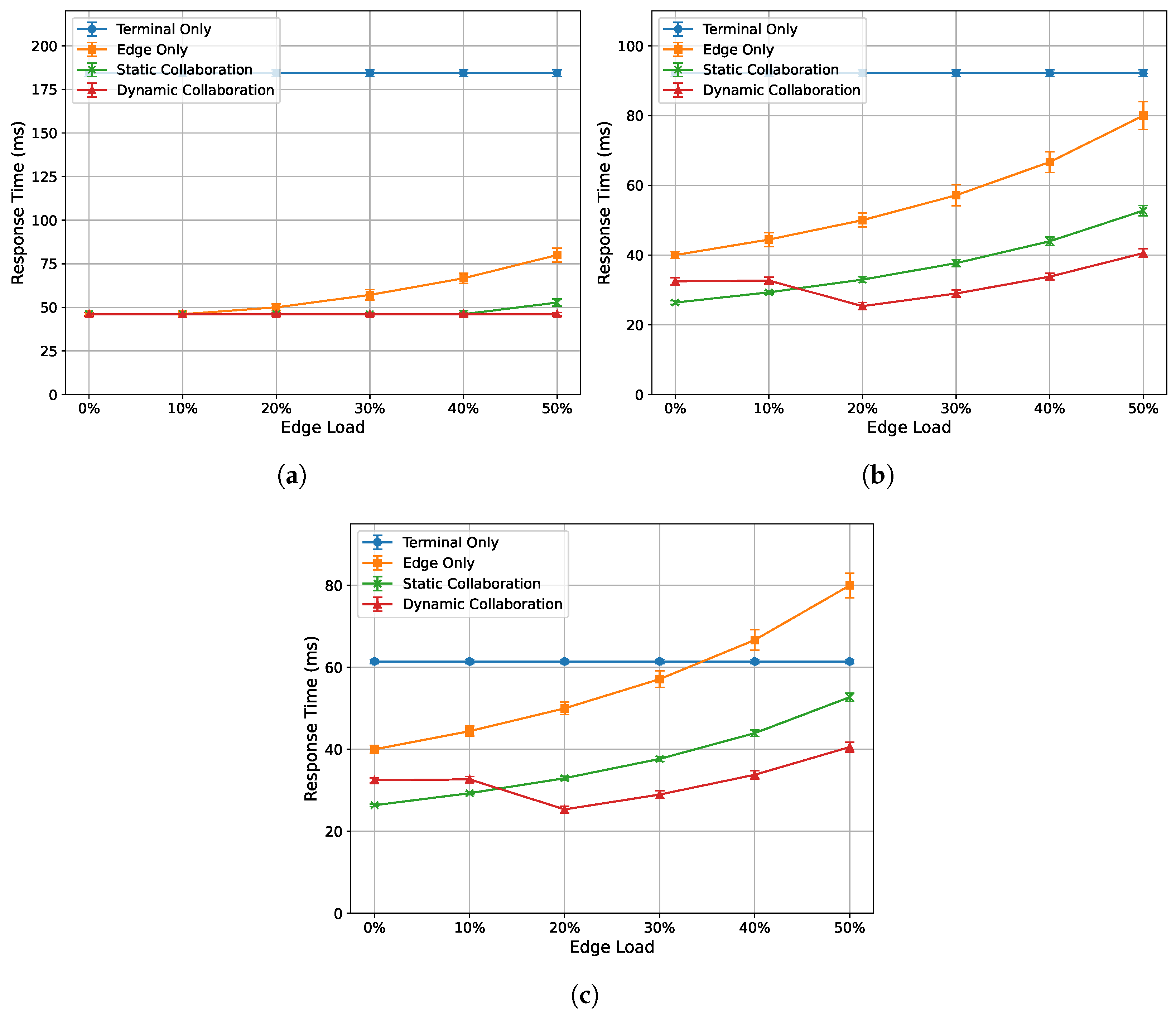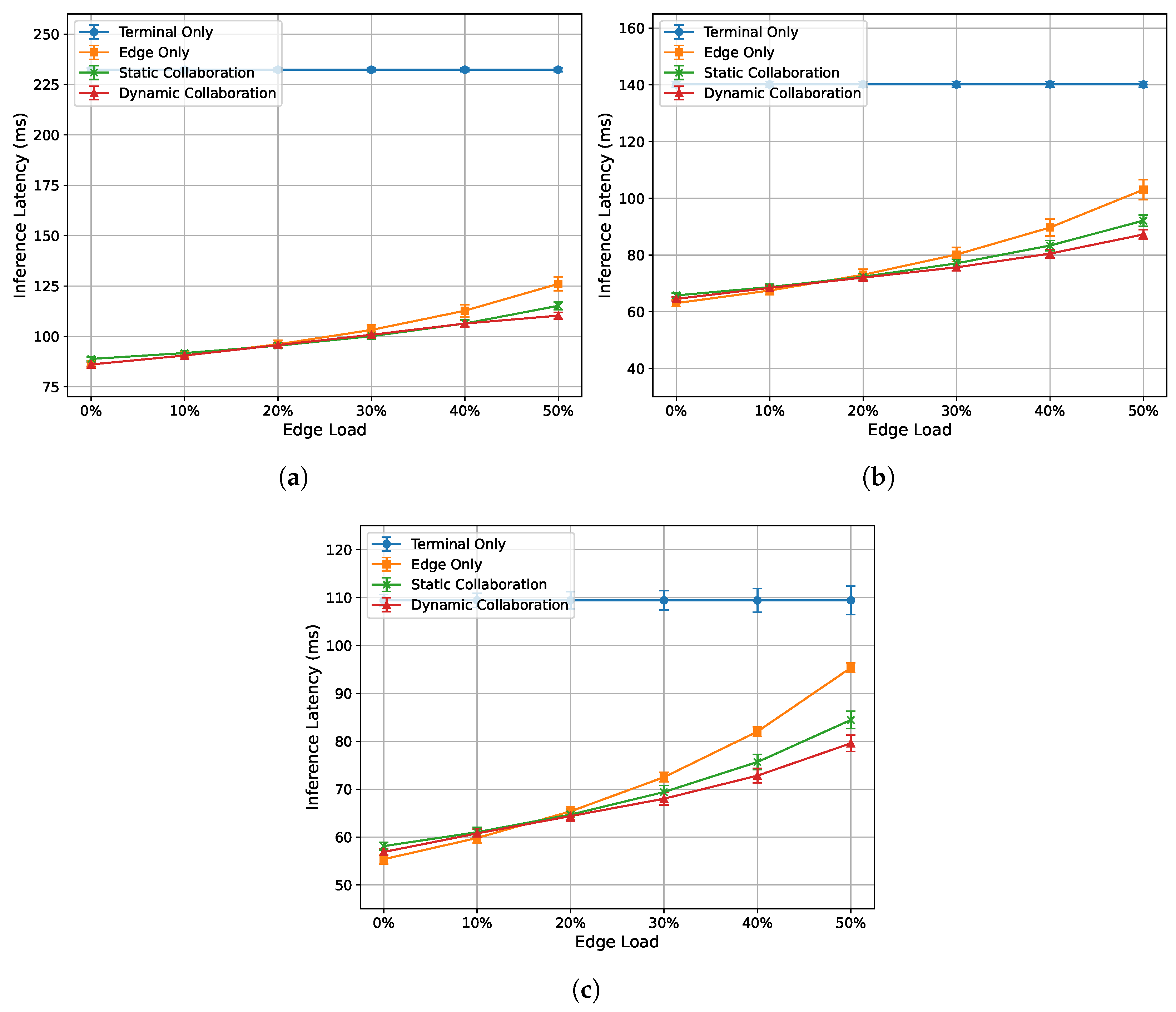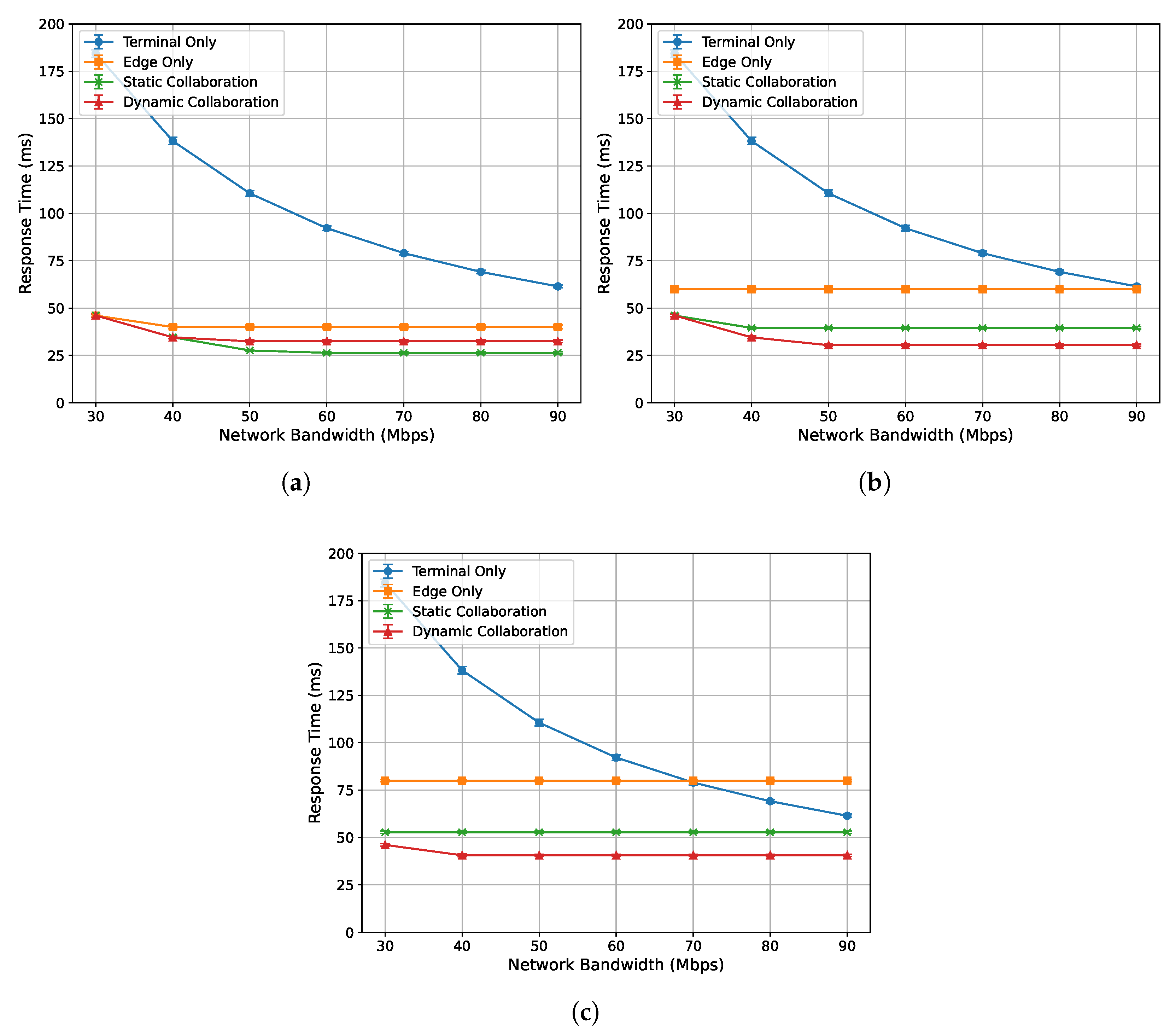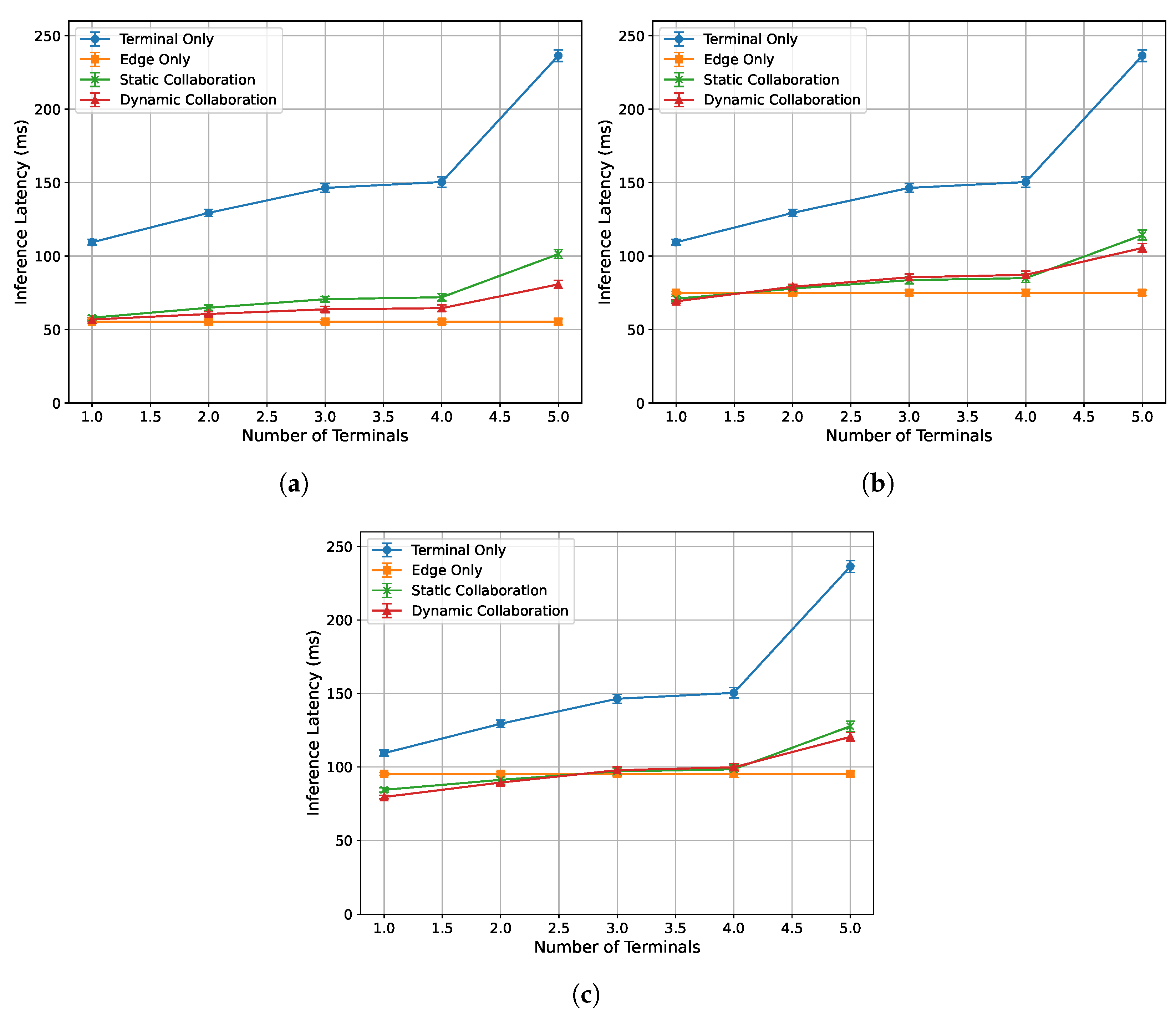Super-Resolution Task Inference Acceleration for In-Vehicle Real-Time Video via Edge–End Collaboration
Abstract
1. Introduction
2. Literature Review
2.1. Edge–End Collaborative Inference Framework
2.2. Video Super-Resolution Techniques
3. Edge-Aware Dynamic Model Partitioning for Super-Resolution Inference
3.1. Overview
- Existing research efforts typically focus on optimizing the total inference latency. However, in video super-resolution tasks, it is more critical to prioritize real-time guarantees for video playback. Specifically, there are strict latency constraints for each part of every frame. If existing approaches are directly applied to video super-resolution tasks, they may result in noticeable video stuttering or lag.
- In edge–end environments where the computational capabilities of end devices differ significantly, it is essential to take into account the computing power of each device and balance the inference latency across end devices, making it challenging to determine the optimal model partitioning strategy.
- Changes in the “edge–end” environment can affect the model partitioning strategy. For example, when other tasks are running on the edge server, increasing its computational load, it may lead to longer inference latency for the super-resolution task. Additionally, end devices often have limited cooling capabilities, and under high loads, they may experience frequency throttling, which degrades their computational performance and increases inference latency. Moreover, unstable network bandwidth between the edge and end devices can also impact transmission latency. Therefore, static neural network partitioning approaches are likely unable to adapt to the dynamic and real-time nature of the edge–end environment.
3.2. Problem Formulation
3.2.1. Parameter Modeling
3.2.2. Constraint Conditions and Objective Function Modeling
3.3. Design Details
3.3.1. Model Partitioning Strategy
| Algorithm 1 Single-terminal task model partitioning algorithm |
| Input: |
| N: Number of DNN layers |
| : Layer sizes of the DNN |
| : Output data volumes of each DNN layer |
| L: Transmission latency per unit data volume |
| : Inference latency function for layer |
| F: Video frame rate |
| Output: Optimal partition position with minimal latency or best real-time performance |
|
| Algorithm 2: Multi-terminal task model partitioning algorithm |
| Input: |
| Edge–end environment, model structure parameters |
| Z: Number of end devices |
| Output: |
| Minimum latency partition positions that prioritize real-time performance |
|
3.3.2. Adaptive Adjustment Strategy
4. Experiment and Results
4.1. Experimental Setup
4.2. Comparison Algorithm Setup
- (1)
- Terminal-only: The inference task is executed solely on the end devices without the involvement of the edge server.
- (2)
- Edge-only: All end devices send raw data to the edge server, and the entire inference task is offloaded to the edge for execution.
- (3)
- Static collaboration: A fixed model partitioning point is determined based on the assumption that the computational load between the front and back parts of the deep neural network model is approximately equal, and the “edge–end” collaborative inference is performed accordingly.
- (4)
- Dynamic collaboration: This refers to the dynamic model partitioning mechanism for multi-terminal task super-resolution based on “edge–end” collaboration, which is proposed in this paper.
4.3. Analysis of Experimental Results
4.3.1. Acceleration Performance Under Varying Edge Load Conditions
4.3.2. Acceleration Performance Under Varying Network Bandwidth Conditions
4.3.3. Acceleration Performance Under Varying Terminal Inference Tasks
5. Conclusions
Author Contributions
Funding
Data Availability Statement
Conflicts of Interest
References
- Barman, N.; Martini, M.G. QoE modeling for HTTP adaptive video streaming–a survey and open challenges. IEEE Access 2019, 7, 30831–30859. [Google Scholar] [CrossRef]
- Barnett, T.; Jain, S.; Andra, U.; Khurana, T. Cisco Visual Networking Index (VNI) Complete Forecast Update, 2017–2022. In Americas/EMEAR Cisco Knowledge Network (CKN) Presentation; Cisco: San Jose, CA, USA, 2018; Volume 1. [Google Scholar]
- Liu, H.; Ruan, Z.; Zhao, P.; Dong, C.; Shang, F.; Liu, Y.; Yang, L.; Timofte, R. Video super-resolution based on deep learning: A comprehensive survey. Artif. Intell. Rev. 2022, 55, 5981–6035. [Google Scholar] [CrossRef]
- Wang, Z.; Chen, J.; Hoi, S.C.H. Deep learning for image super-resolution: A survey. IEEE Trans. Pattern Anal. Mach. Intell. 2020, 43, 3365–3387. [Google Scholar] [CrossRef]
- Chauhan, K.; Patel, S.N.; Kumhar, M.; Bhatia, J.; Tanwar, S.; Davidson, I.E.; Mazibuko, T.F.; Sharma, R. Deep Learning-based Single-image Super-resolution: A comprehensive review. IEEE Access 2023, 11, 21811–21830. [Google Scholar]
- Hui, Z.; Wang, X.; Gao, X. Fast and Accurate Single Image Super-Resolution via Information Distillation Network. In Proceedings of the Conference on Computer Vision and Pattern Recognition (CVPR), Salt Lake City, UT, USA, 18–23 June 2018; pp. 723–731. [Google Scholar]
- Lee, R.; Venieris, S.I.; Dudziak, L.; Bhattacharya, S.; Lane, N.D. Mobisr: Efficient on-device super-resolution through heterogeneous mobile processors. In Proceedings of the 25th Annual International Conference on Mobile Computing and Networking, Los Cabos, Mexico, 21–25 October 2019; pp. 1–16. [Google Scholar]
- Kong, X.; Zhao, H.; Qiao, Y.; Dong, C. Classsr: A general framework to accelerate super-resolution networks by data characteristic. In Proceedings of the IEEE/CVF Conference on Computer Vision and Pattern Recognition, Nashville, TN, USA, 20–25 June 2021; pp. 12016–12025. [Google Scholar]
- Yi, J.; Kim, S.; Kim, J.; Choi, S. Supremo: Cloud-assisted low-latency super-resolution in mobile devices. IEEE Trans. Mob. Comput. 2020, 21, 1847–1860. [Google Scholar] [CrossRef]
- Hui, Z.; Gao, X.; Yang, Y.; Wang, X. Lightweight image super-resolution with information multi-distillation network. In Proceedings of the 27th ACM International Conference on Multimedia, Nice, France, 21–25 October 2019; pp. 2024–2032. [Google Scholar]
- Xie, B.; Xu, H.; Joe, Y.J.; Seo, D.; Cai, Z. Lightweight Super-Resolution Model for Complete Model Copyright Protection. Tsinghua Sci. Technol. 2023, 29, 1194–1205. [Google Scholar] [CrossRef]
- Elgazzar, K.; Martin, P.; Hassanein, H.S. Cloud-Assisted Computation Offloading to Support Mobile Services. IEEE Trans. Cloud Comput. 2016, 4, 279–292. [Google Scholar] [CrossRef]
- Ojo, M.O.; Giordano, S.; Procissi, G.; Seitanidis, I.N. A Review of Low-End, Middle-End, and High-End IoT Devices. IEEE Access 2018, 6, 70528–70554. [Google Scholar] [CrossRef]
- Akherfi, K.; Gerndt, M.; Harroud, H. Mobile cloud computing for computation offloading: Issues and challenges. Appl. Comput. Inform. 2018, 14, 1–16. [Google Scholar] [CrossRef]
- Li, M.; Zhang, X.; Guo, J.; Li, F. Cloud–Edge Collaborative Inference with Network Pruning. Electronics 2023, 12, 3598. [Google Scholar] [CrossRef]
- Pagliari, D.J.; Chiaro, R.; Macii, E.; Poncino, M. Crime: Input-dependent collaborative inference for recurrent neural networks. IEEE Trans. Comput. 2020, 70, 1626–1639. [Google Scholar]
- Kou, Z.; Liu, Z.; Yang, X.; He, X. Adaptive Deep Inference Framework for Cloud-Edge Collaboration. In Proceedings of the 2023 International Conference on Computers, Information Processing and Advanced Education (CIPAE), Ottawa, ON, Canada, 26–28 August 2023; IEEE: Now York, NY, USA, 2023; pp. 46–49. [Google Scholar]
- Li, M.; Yang, L.; Huang, J. A Deep Reinforcement Learning Approach for DNN Collaborative Inference in Mobile Edge Computing. In Proceedings of the 2023 10th International Conference on Electrical and Electronics Engineering (ICEEE), Istanbul, Türkiye, 8–10 May 2023; IEEE: Now York, NY, USA, 2023; pp. 248–254. [Google Scholar]
- Hao, Z.; Xu, G.; Luo, Y.; Hu, H.; An, J.; Mao, S. Multi-agent collaborative inference via DNN decoupling: Intermediate feature compression and edge learning. IEEE Trans. Mob. Comput. 2022, 22, 6041–6055. [Google Scholar] [CrossRef]
- Xiao, Y.; Xiao, L.; Wan, K.; Yang, H.; Zhang, Y.; Wu, Y.; Zhang, Y. Reinforcement learning based energy-efficient collaborative inference for mobile edge computing. IEEE Trans. Commun. 2022, 71, 864–876. [Google Scholar] [CrossRef]
- Yang, X.; Esquivel, J.A. LSTM network-based adaptation approach for dynamic integration in intelligent end-edge-cloud systems. Tsinghua Sci. Technol. 2024, 29, 1219–1231. [Google Scholar] [CrossRef]
- Di Francia, G.T. Resolving power and information. J. Opt. Soc. Am. 1955, 45, 497–501. [Google Scholar] [CrossRef]
- Harris, J.L. Diffraction and resolving power. J. Opt. Soc. Am. 1964, 54, 931–936. [Google Scholar] [CrossRef]
- Goodman, J.W. Introduction to Fourier Optics; Roberts and Company Publishers: Greenwood Village, CO, USA, 2005. [Google Scholar]
- Du, W.; Tian, S. Transformer and GAN-based super-resolution reconstruction network for medical images. Tsinghua Sci. Technol. 2023, 29, 197–206. [Google Scholar] [CrossRef]
- Chen, S.E.; Williams, L. View interpolation for image synthesis. Semin. Graph. Pap. Push. Boundaries 2023, 2, 423–432. [Google Scholar]
- Wei, Z.; Ma, K.-K. Contrast-guided image interpolation. IEEE Trans. Image Process. 2013, 22, 4271–4285. [Google Scholar] [CrossRef] [PubMed]
- Zhang, X.; Ma, S.; Zhang, Y.; Zhang, L.; Gao, W. Nonlocal edge-directed interpolation. In Pacific-Rim Conference on Multimedia; Springer: Berlin/Heidelberg, Germany, 2009; pp. 1197–1207. [Google Scholar]
- Ogawa, T.; Haseyama, M. Missing intensity interpolation using a kernel PCA-based POCS algorithm and its applications. IEEE Trans. Image Process. 2010, 20, 417–432. [Google Scholar] [CrossRef] [PubMed]
- Liu, J.; Xue, R.; Li, Y. Single image super-resolution reconstruction based on multi-directionality of the edge. In Proceedings of the Eleventh International Conference on Digital Image Processing (ICDIP 2019), Guangzhou, China, 10–13 May 2019; Volume 11179, pp. 306–313. [Google Scholar]
- Freeman, W.T.; Jones, T.R.; Pasztor, E.C. Example-based super-resolution. IEEE Comput. Graph. Appl. 2002, 22, 56–65. [Google Scholar] [CrossRef]
- Yang, J.; Wright, J.; Huang, T.; Ma, Y. Image super-resolution as sparse representation of raw image patches. In Proceedings of the 2008 IEEE Conference on Computer Vision and Pattern Recognition, Anchorage, AK, USA, 23–28 June 2008; IEEE: Now York, NY, USA, 2008; pp. 1–8. [Google Scholar]
- Mora-Martinez, Y.G.; Ponomaryov, V.I.; Garcia-Salgado, B.P.; Reyes-Reyes, R.; Cruz-Ramos, C. Real-time video super-resolution reconstruction using wavelet transforms and sparse representation. In Real-Time Processing of Image, Depth and Video Information; SPIE: Bellingham, WA, USA, 2023; Volume 12571, pp. 31–40. [Google Scholar]
- Dong, C.; Loy, C.C.; He, K.; Tang, X. Learning a deep convolutional network for image super-resolution. In Proceedings of the Computer Vision–ECCV 2014, 13th European Conference, Zurich, Switzerland, 6–12 September 2014; Proceedings, Part IV 13. Springer International Publishing: Berlin/Heidelberg, Germany, 2014; pp. 184–199. [Google Scholar]
- Dong, C.; Loy, C.C.; Tang, X. Accelerating the super-resolution convolutional neural network. In Proceedings of the Computer Vision–ECCV 2016, 14th European Conference, Amsterdam, The Netherlands, 11–14 October 2016; Proceedings, Part II 14. Springer International Publishing: Berlin/Heidelberg, Germany, 2016; pp. 391–407. [Google Scholar]
- Kim, J.; Lee, J.K.; Lee, K.M. Accurate image super-resolution using very deep convolutional networks. In Proceedings of the IEEE Conference on Computer Vision and Pattern Recognition, Las Vegas, NV, USA, 27–30 June 2016; pp. 1646–1654. [Google Scholar]
- Zhang, Z.; Wang, Z.; Lin, Z.; Qi, H. Image super-resolution by neural texture transfer. In Proceedings of the IEEE/CVF Conference on Computer Vision and Pattern Recognition, Long Beach, CA, USA, 15–20 June 2019; pp. 7982–7991. [Google Scholar]
- Kim, J.; Lee, J.K.; Lee, K.M. Deeply-recursive convolutional network for image super-resolution. In Proceedings of the IEEE Conference on Computer Vision and Pattern Recognition, Las Vegas, NV, USA, 27–30 June 2016; pp. 1637–1645. [Google Scholar]
- Tai, Y.; Yang, J.; Liu, X. Image super-resolution via deep recursive residual network. In Proceedings of the IEEE Conference on Computer Vision and Pattern Recognition, Honolulu, HI, USA, 21–26 July 2017; pp. 3147–3155. [Google Scholar]
- Ledig, C.; Theis, L.; Huszár, F.; Caballero, J.; Cunningham, A.; Acosta, A.; Aitken, A.; Tejani, A.; Totz, J.; Wang, Z.; et al. Photo-realistic single image super-resolution using a generative adversarial network. In Proceedings of the IEEE Conference on Computer Vision and Pattern Recognition, Honolulu, HI, USA, 21–26 July 2017; pp. 4681–4690. [Google Scholar]
- Lim, B.; Son, S.; Kim, H.; Nah, S.; Mu Lee, K. Enhanced deep residual networks for single image super-resolution. In Proceedings of the IEEE Conference on Computer Vision and Pattern Recognition Workshops, Honolulu, HI, USA, 21–26 July 2017; pp. 136–144. [Google Scholar]
- Tong, T.; Li, G.; Liu, X.; Gao, Q. Image super-resolution using dense skip connections. In Proceedings of the IEEE International Conference on Computer Vision, Venice, Italy, 22 –29 October 2017; pp. 4799–4807. [Google Scholar]
- Zhang, Y.; Li, K.; Li, K.; Wang, L.; Zhong, B.; Fu, Y. Image super-resolution using very deep residual channel attention networks. In Proceedings of the European Conference on Computer Vision (ECCV), Munich, Germany, 8–14 September 2018; pp. 286–301. [Google Scholar]
- Wang, L.; Guo, Y.; Lin, Z.; Deng, X.; An, W. Learning for video super-resolution through HR optical flow estimation. In Proceedings of the Computer Vision–ACCV 2018, 14th Asian Conference on Computer Vision, Perth, Australia, 2–6 December 2018; Revised Selected Papers, Part I 14. Springer International Publishing: Berlin/Heidelberg, Germany, 2019; pp. 514–529. [Google Scholar]
- Sajjadi, M.S.M.; Vemulapalli, R.; Brown, M. Frame-recurrent video super-resolution. In Proceedings of the IEEE Conference on Computer Vision and Pattern Recognition, Salt Lake City, UT, USA, 18–23 June 2018; pp. 6626–6634. [Google Scholar]
- Yan, B.; Lin, C.; Tan, W. Frame and feature-context video super-resolution. In Proceedings of the AAAI Conference on Artificial Intelligence, Honolulu, HI, USA, 27 January–1 February 2019; Volume 33, pp. 5597–5604. [Google Scholar]
- Chan, K.C.; Wang, X.; Yu, K.; Dong, C.; Loy, C.C. BasicVSR: The search for essential components in video super-resolution and beyond. In Proceedings of the IEEE/CVF Conference on Computer Vision and Pattern Recognition, Nashville, TN, USA, 20–25 June 2021; pp. 4947–4956. [Google Scholar]
- Chan, K.C.; Zhou, S.; Xu, X.; Loy, C.C. Investigating tradeoffs in real-world video super-resolution. In Proceedings of the IEEE/CVF Conference on Computer Vision and Pattern Recognition, New Orleans, LA, USA, 18–24 June 2022; pp. 5962–5971. [Google Scholar]
- Liu, C.; Yang, H.; Fu, J.; Qian, X. Learning trajectory-aware transformer for video super-resolution. In Proceedings of the IEEE/CVF Conference on Computer Vision and Pattern Recognition, New Orleans, LA, USA, 18–24 June 2022; pp. 5687–5696. [Google Scholar]
- Wen, W.; Ren, W.; Shi, Y.; Nie, Y.; Zhang, J.; Cao, X. Video super-resolution via a spatio-temporal alignment network. IEEE Trans. Image Process. 2022, 31, 1761–1773. [Google Scholar] [CrossRef]
- Chan, K.C.; Zhou, S.; Xu, X.; Loy, C.C. BasicVSR++: Improving video super-resolution with enhanced propagation and alignment. In Proceedings of the IEEE/CVF Conference on Computer Vision and Pattern Recognition, New Orleans, LA, USA, 18–24 June 2022; pp. 5972–5981. [Google Scholar]
- Yang, Z.; Wang, X.; Wu, J.; Zhao, Y.; Ma, Q.; Miao, X.; Zhang, L.; Zhou, Z. Edgeduet: Tiling small object detection for edge assisted autonomous mobile vision. IEEE/ACM Trans. Netw. 2022, 31, 1765–1778. [Google Scholar] [CrossRef]
- Monderer, D.; Shapley, L.S. Potential games. Games Econ. Behav. 1996, 14, 124–143. [Google Scholar] [CrossRef]
- Li, L.; Xu, K.; Li, T.; Zheng, K.; Peng, C.; Wang, D.; Wang, X.; Shen, M.; Mijumbi, R. A measurement study on multi-path TCP with multiple cellular carriers on high speed rails. In Proceedings of the 2018 Conference of the ACM Special Interest Group on Data Communication, Budapest, Hungary, 20–25 August 2018; pp. 161–175. [Google Scholar]
- Raca, D.; Quinlan, J.J.; Zahran, A.H.; Sreenan, C.J. Beyond throughput: A 4G LTE dataset with channel and context metrics. In Proceedings of the 9th ACM Multimedia Systems Conference, Amsterdam, The Netherlands, 12–15 June 2018; pp. 460–465. [Google Scholar]









| Notations | Descriptions |
|---|---|
| N | Number of layers in the super-resolution deep neural network (DNN) |
| Output data volume of the i-th layer of the DNN under specific input data volume, where | |
| Computational volume of the i-th layer of the DNN under specific input data volume, where | |
| Specific input data volume | |
| Current input data volume of end device j, where | |
| Inference latency per unit computational volume on end device j, where | |
| Inference latency per unit computational volume on the edge server | |
| Transmission latency per unit data volume on end device j, where | |
| F | Frequency |
| Position of model partitioning for inference tasks after network transmission, where | |
| Z | Number of end devices |
Disclaimer/Publisher’s Note: The statements, opinions and data contained in all publications are solely those of the individual author(s) and contributor(s) and not of MDPI and/or the editor(s). MDPI and/or the editor(s) disclaim responsibility for any injury to people or property resulting from any ideas, methods, instructions or products referred to in the content. |
© 2025 by the authors. Licensee MDPI, Basel, Switzerland. This article is an open access article distributed under the terms and conditions of the Creative Commons Attribution (CC BY) license (https://creativecommons.org/licenses/by/4.0/).
Share and Cite
Zhou, L.; Li, Y.; Feng, Y.; Shen, D.; Wang, H.; Dong, F. Super-Resolution Task Inference Acceleration for In-Vehicle Real-Time Video via Edge–End Collaboration. Appl. Sci. 2025, 15, 11828. https://doi.org/10.3390/app152111828
Zhou L, Li Y, Feng Y, Shen D, Wang H, Dong F. Super-Resolution Task Inference Acceleration for In-Vehicle Real-Time Video via Edge–End Collaboration. Applied Sciences. 2025; 15(21):11828. https://doi.org/10.3390/app152111828
Chicago/Turabian StyleZhou, Liming, Yafei Li, Yulong Feng, Dian Shen, Hui Wang, and Fang Dong. 2025. "Super-Resolution Task Inference Acceleration for In-Vehicle Real-Time Video via Edge–End Collaboration" Applied Sciences 15, no. 21: 11828. https://doi.org/10.3390/app152111828
APA StyleZhou, L., Li, Y., Feng, Y., Shen, D., Wang, H., & Dong, F. (2025). Super-Resolution Task Inference Acceleration for In-Vehicle Real-Time Video via Edge–End Collaboration. Applied Sciences, 15(21), 11828. https://doi.org/10.3390/app152111828





